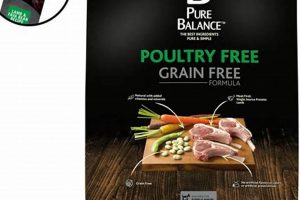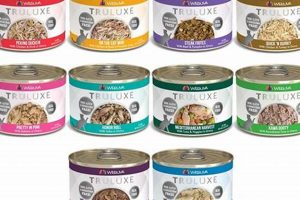Angel food cake, a traditionally light and airy dessert, gains a modified iteration through the adaptation of formulations that eliminate sucrose. The resulting product is intended for individuals managing dietary sugar intake or those seeking reduced-calorie options. Preparation involves meringue, flour, and a sweetener alternative to create a similar texture and volume to the original dessert.
The significance of developing a version without refined sugar resides in its potential to broaden the appeal of this dessert to a wider demographic, including those with diabetes or those following specific dietary regimens. Historically, desserts high in sugar content have been restricted for these groups. The creation of alternative recipes provides an option that aligns with their health requirements without entirely sacrificing the enjoyment of a sweet treat.
The subsequent sections will elaborate on sweetener choices, optimal baking techniques, and potential challenges encountered during the preparation of this modified dessert. These elements are critical for achieving a successful outcome, replicating the desired qualities of the original recipe while adhering to the parameters of reduced or absent sucrose.
Preparation Guidance
Achieving optimal results when creating a sucrose-free angel food cake necessitates careful attention to specific details throughout the baking process. The following recommendations are intended to enhance the likelihood of a successful outcome.
Tip 1: Sweetener Selection: The choice of sweetener significantly impacts the final product. Opt for a high-intensity sweetener, such as erythritol or stevia, specifically formulated for baking. Adjust quantities according to the manufacturer’s guidelines, as conversion ratios differ from sucrose.
Tip 2: Egg White Preparation: Egg whites should be at room temperature before whisking. Ensure that the bowl and whisk are scrupulously clean and free from any traces of fat. Fat inhibits the formation of a stable meringue, a crucial element in angel food cake.
Tip 3: Meringue Stability: Gradually incorporate the sweetener into the egg whites as they are being whisked. This technique contributes to a more stable meringue. Whisk until stiff, glossy peaks form.
Tip 4: Flour Incorporation: Use cake flour and sift it multiple times to ensure a fine consistency. Gently fold the flour into the meringue in stages, being careful not to deflate the mixture. Overmixing results in a dense cake.
Tip 5: Pan Preparation: Use an ungreased angel food cake pan. The cake needs to adhere to the sides of the pan to rise properly. Avoid non-stick pans for this reason.
Tip 6: Baking Temperature and Time: Adhere to the recommended baking temperature and time in the recipe. Oven temperatures may vary, so monitor the cake closely. A toothpick inserted into the center should come out clean.
Tip 7: Cooling Procedure: Invert the cake immediately after baking and allow it to cool completely in the pan. This prevents the cake from collapsing.
Adhering to these suggestions contributes to a sucrose-free angel food cake that replicates the light texture and volume of the original while meeting specific dietary requirements. Careful execution of each step is essential for a satisfactory result.
The subsequent section will address potential challenges and troubleshooting strategies associated with this unique baking endeavor. Understanding these aspects can further improve the overall success rate.
1. Sweetener Substitution
Sweetener substitution represents a pivotal element in the successful formulation of a sucrose-free angel food cake. This modification requires careful consideration to replicate the functional properties of sucrose, which contribute not only to sweetness but also to the structure and moisture content of the final product.
- Sweetener Type and Impact on Texture
The selection of an alternative sweetener directly influences the cake’s texture. Bulk sweeteners, such as erythritol, may provide a more similar mouthfeel to sucrose, while high-intensity sweeteners like stevia or sucralose require careful adjustment of other ingredients to compensate for the lack of bulk. Inadequate adjustments can result in a dry or crumbly texture.
- Moisture Retention Considerations
Sucrose contributes to moisture retention in baked goods. When substituting, additional ingredients may be necessary to maintain adequate hydration. Ingredients like applesauce or yogurt, used in small quantities, can help prevent the finished cake from becoming overly dry.
- Browning Characteristics
Sucrose caramelizes during baking, contributing to browning. Many alternative sweeteners do not possess the same browning capabilities. The addition of small amounts of maltodextrin or the use of a convection oven can help promote browning and enhance the cake’s visual appeal.
- Impact on Meringue Stability
The integration of the chosen sweetener into the meringue is crucial for volume and stability. Finely granulated sweeteners dissolve more readily into the egg whites, contributing to a smoother and more stable meringue. Coarse sweeteners may require pre-grinding to ensure proper incorporation.
Consequently, the process of replacing sucrose necessitates a nuanced understanding of its multifaceted role in angel food cake. Adjustments must be made across various aspects of the formulation to ensure that the resulting sucrose-free version maintains the desired characteristics of the traditional dessert. Failure to address these interconnected factors can compromise the final product’s quality.
2. Meringue Stability
Meringue stability constitutes a critical factor in the structural integrity of a sucrose-free angel food cake. The meringue, formed from whipped egg whites, provides the foundation for the cake’s signature light and airy texture. Achieving and maintaining a stable meringue is essential, particularly when sucrose, a traditional stabilizer, is absent.
- Sweetener Incorporation and Meringue Structure
The manner in which alternative sweeteners are incorporated into the egg whites significantly affects meringue stability. Gradual addition, as opposed to a single addition, allows for more even distribution and prevents collapse of the foam structure. The type of sweetener also plays a role; powdered or finely granulated sweeteners generally integrate more readily than coarser varieties, minimizing disruption to the meringue’s network of air bubbles.
- Acidity and Protein Denaturation
The addition of an acidic ingredient, such as cream of tartar or lemon juice, aids in stabilizing the egg white proteins. These acids lower the pH, facilitating protein denaturation and strengthening the bonds within the meringue. A more stable protein matrix translates to increased volume and reduced weeping during baking.
- Over-Whisking and Protein Breakdown
While proper whisking is crucial for meringue formation, over-whisking can lead to protein breakdown and a destabilized structure. Over-whisked meringues appear dry and curdled. Careful monitoring of the meringue’s texture is necessary to avoid this outcome.
- Temperature Influence and Meringue Collapse
Temperature fluctuations can compromise meringue stability. Sudden temperature changes during baking can cause the air bubbles within the meringue to expand and rupture, leading to cake collapse. Maintaining a consistent oven temperature and avoiding premature opening of the oven door are important for preserving the meringue’s structural integrity.
These facets collectively highlight the intricate relationship between meringue stability and the overall success of a sucrose-free angel food cake. Careful attention to sweetener integration, acidity levels, whisking duration, and temperature control is essential for achieving the desired light, airy texture characteristic of this modified dessert. Failure to address these elements can result in a dense or collapsed cake, undermining the intended qualities of the recipe.
3. Flour Type
Flour type exerts a significant influence on the texture and structure of a sucrose-free angel food cake. The selection of flour directly impacts the cake’s ability to achieve its characteristic light and airy consistency. Traditional angel food cake recipes rely on cake flour due to its low protein content. This low protein level minimizes gluten development, resulting in a tender crumb. Substituting with all-purpose flour, which contains a higher protein percentage, would yield a denser and chewier product, deviating from the desired texture. The impact is exacerbated in sucrose-free versions because sucrose, in addition to providing sweetness, contributes to tenderness by inhibiting gluten formation; its absence further accentuates the effect of flour choice.
Consider a practical example: Two batches of sucrose-free angel food cake are prepared, with all variables held constant except for flour type. The first batch utilizes cake flour, resulting in a delicate, fine-crumbed cake with substantial volume. The second batch employs all-purpose flour. This cake exhibits a noticeably reduced volume, a denser texture, and a tougher crumb. The gluten network, more developed due to the higher protein content, resists the expansion of air bubbles during baking, leading to the less desirable outcome. This underscores the critical role of flour selection in achieving the anticipated qualities of this specific dessert.
In summary, the success of a sucrose-free angel food cake hinges, in part, on the appropriate selection of flour. Cake flour, with its low protein content, is essential for preventing excessive gluten development and ensuring a tender, airy texture. While other modifications might be necessary to compensate for the absence of sucrose, the flour type serves as a fundamental element in achieving the desired outcome. Misunderstanding or disregarding this aspect can lead to a significantly different, and likely less satisfactory, final product. The practical implication is clear: adherence to the correct flour specification is paramount when preparing this modified dessert.
4. Baking Time
Baking time represents a crucial variable in the preparation of a sucrose-free angel food cake. Accurate regulation of this parameter is essential to ensure proper structural development and prevent undesirable textural outcomes. The absence of sucrose necessitates adjustments to standard baking protocols.
- Sweetener Influence on Browning
Alternative sweeteners often exhibit different browning characteristics compared to sucrose. Certain sweeteners may not caramelize to the same extent, potentially resulting in a paler cake surface. Baking time adjustments may be required to achieve a visually appealing golden-brown color; however, extending the time excessively can lead to dryness.
- Moisture Content Regulation
Sucrose contributes to moisture retention in baked goods. When replaced, the recipe’s susceptibility to drying out increases. Monitoring the cake’s internal temperature and adjusting the baking time accordingly becomes critical. Overbaking will lead to a dry, crumbly texture; underbaking will result in a gummy or undercooked center.
- Meringue Stability and Structural Integrity
Prolonged baking times can negatively impact the stability of the meringue, which provides the cake’s structure. Excessive heat exposure can cause the meringue to dry out and collapse, resulting in a dense and shrunken cake. Careful observation and adherence to recommended baking durations are essential for preserving the meringue’s structural integrity.
- Internal Temperature Monitoring
Relying solely on visual cues can be misleading. Employing a food thermometer to monitor the cake’s internal temperature offers a more precise method for determining doneness. The target internal temperature should align with the specific recipe guidelines to ensure adequate cooking without over-drying.
The interplay between sweetener properties, moisture retention, meringue stability, and internal temperature underscores the importance of precise baking time control. The successful preparation of a sucrose-free angel food cake hinges on the ability to carefully manage this parameter, adapting baking protocols to compensate for the absence of sucrose and achieve the desired light, airy texture.
5. Cooling Method
The cooling method represents a critical, often overlooked, stage in the preparation of a sucrose-free angel food cake. Its significance stems from the unique structural properties of this dessert and the changes that occur as it transitions from the high temperatures of the oven to room temperature. Improper cooling can undermine the efforts invested in the previous steps, resulting in a collapsed or otherwise compromised final product.
- Inversion and Structural Support
The standard cooling procedure involves inverting the cake pan immediately after removal from the oven. This technique leverages gravity to counteract the effects of internal pressure changes and structural weakening that occur as the cake cools. By inverting the pan onto a wire rack or bottle neck, the cake’s weight is distributed evenly, preventing collapse and preserving the delicate airy texture.
- Adherence and Pan Design
Angel food cake pans are designed with a central tube and straight sides to facilitate adherence during both baking and cooling. The cake clings to these surfaces, providing essential support as it cools and its internal structure sets. Non-stick pans should be avoided, as they prevent the necessary adherence, increasing the risk of collapse. The absence of sucrose further emphasizes the importance of this adherence, as sucrose contributes to structural integrity.
- Cooling Duration and Moisture Control
Allowing the cake to cool completely in the inverted pan is essential for optimal results. Premature removal can disrupt the setting process and lead to structural failure. The cooling duration also influences moisture distribution within the cake. A gradual cooling process helps to equalize moisture levels, preventing the development of gummy or overly dry areas. Generally, a minimum of one to two hours of cooling is recommended.
- Extraction Technique and Surface Integrity
Once cooled, careful extraction from the pan is necessary to maintain the cake’s surface integrity. A thin-bladed knife or spatula is typically used to gently loosen the cake from the pan’s sides and central tube. Rushing this process can damage the cake’s delicate crust and compromise its visual appeal. Slow, deliberate movements are essential to preserve the cake’s structural and aesthetic qualities.
In summary, the cooling method is not merely a passive step but an active process that significantly impacts the final outcome of a sucrose-free angel food cake. The inversion technique, pan design considerations, cooling duration, and extraction technique all contribute to the cake’s structural stability, texture, and visual appearance. Mastering this aspect of the recipe is crucial for consistently producing a high-quality, sucrose-free dessert.
Frequently Asked Questions
This section addresses common inquiries regarding the preparation of a sucrose-free angel food cake. The following questions and answers aim to provide clarity and guidance on various aspects of this specialized baking endeavor.
Question 1: What are the most suitable sucrose alternatives for this recipe?
Erythritol, stevia, and sucralose are commonly employed. The selection depends on individual taste preferences and specific dietary requirements. Conversion ratios differ; adherence to manufacturer guidelines is crucial.
Question 2: How does the absence of sucrose affect the cake’s texture?
Sucrose contributes to moisture retention and tenderness. Its removal can result in a drier or tougher cake. Adjustments to liquid content or the addition of moisture-retaining agents may be necessary.
Question 3: Why is it essential to use an ungreased angel food cake pan?
The cake requires adherence to the pan’s sides to achieve proper rise and prevent collapse during cooling. Grease interferes with this adhesion, compromising the cake’s structure.
Question 4: Can all-purpose flour be substituted for cake flour?
Cake flour is preferred due to its lower protein content, which minimizes gluten development and promotes a tender crumb. All-purpose flour yields a denser, chewier texture.
Question 5: How can a stable meringue be achieved without sucrose?
Gradual sweetener incorporation, the addition of an acid (e.g., cream of tartar), and meticulous whisking are essential for meringue stability. Over-whisking should be avoided.
Question 6: What is the recommended cooling procedure for a sucrose-free angel food cake?
Inverting the cake immediately after baking and allowing it to cool completely in the pan prevents collapse. Premature removal can disrupt the setting process.
In summary, the successful preparation of this modified dessert requires careful attention to sweetener selection, ingredient ratios, baking techniques, and cooling procedures. Addressing these factors contributes to a satisfactory outcome.
The subsequent section will provide a comparative analysis between traditional angel food cake and the sucrose-free variant, highlighting the key differences and adaptations.
Conclusion
The foregoing analysis provides a comprehensive overview of the “sugar free angel food cake recipe” category. Key considerations encompass sweetener selection, meringue stabilization, flour type, baking time adjustment, and appropriate cooling methods. These modifications are essential to replicate the desired texture and volume of traditional angel food cake while adhering to the parameters of reduced or absent sucrose content. Success hinges on a thorough understanding of ingredient functionalities and their interplay.
Further exploration into the long-term effects of alternative sweeteners on baked goods, coupled with ongoing refinement of existing formulations, remains warranted. Continued research and meticulous application of established principles will refine this specialized area of culinary science, potentially expanding the availability and palatability of desserts tailored to specific dietary needs. The precision and methodology inherent in recipe adaptation dictate the ultimate outcome of these sucrose-restricted culinary endeavors.




![Gluten-Free Thai: What to Eat & Recipes [Guide] World’s Most Delicious Foods: Must-Try Dishes from Every Country Gluten-Free Thai: What to Eat & Recipes [Guide] | World’s Most Delicious Foods: Must-Try Dishes from Every Country](https://lisasfoods.com/wp-content/uploads/2025/12/th-442-300x200.jpg)


